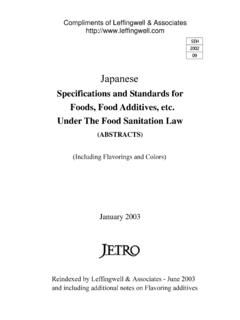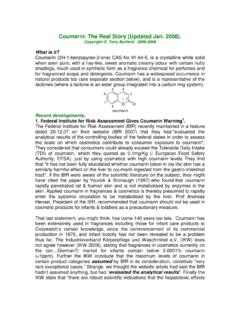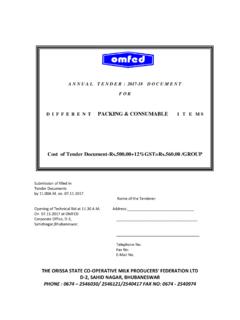Transcription of Identification of the Volatile Constituents of Raw …
1 Identification of the Volatile Constituents of Raw Pumpkin (Cucurbita pepo L.) by Dynamic Headspace Analyses by John C. Leffingwell*1, E. D. Alford2, Diane Leffingwell1 1 Leffingwell & Associates, Canton, GA 30115 USA 2 Alford Consulting, Louisville, KY 40207 USA Summary The Volatile Constituents of Raw Pumpkin , (Cucurbita pepo L. subsp. pepo - Howden Pumpkin cultivar a Connecticut Field type ) were determined by dynamic headspace GC-MS analyses . In excess of 11 0 Volatile Constituents were identified. Analysis of the fibrous stringy and/or seedy portions gave primarily (Z) -3- hexenol and 1- hexanol while the meat or flesh portion was dominated by 2- propanol and dimethyl disulfide. Significant quantities of dimethyl disulfide and dimethyl trisulfide were found in all samples.
2 Background: The genus Cucurbita is a member of the Cucurbitaceae plant family which includes squash (including pumpkin), zucchini, and some gourds. These were first cultivated in the Andes and Mesoamerica. The Cucurbita genus includes five major species which comprise the majority of pumpkins and squashes - Cucurbita pepo, Cucurbita moschata, Cucurbita maxima, Cucurbita argyrosperma and Cucurbita ficifolia. Many hundreds of varieties and cultivars of these are grown around the world and are major agricultural commodities. In 2012, The Food and Agriculture Organization of the United Nations (FAOSTAT) estimates that 24,616 million tons of pumpkins, squash and gourds were produced, with the following countries being the major producers: China (7,063 mil. tons), India (4,900 mil.)
3 Tons), Russian Federation (1,081 mil. tons), Iran (965 mil. tons) and the USA (901 mil. tons). Pumpkins* are grown primarily for processing with a lesser percentage being grown for festivals ( Halloween) or ornamental sales. Uses for foods include everything from pumpkin pie to pumpkin bread and even curries. Roasted pumpkin seeds are used for snacks and the pressed oil of roasted seeds is popular for salad dressings, especially in Europe. Previous work: No analyses of the Volatile Constituents of raw pumpkin (Cucurbita Pepo L.) has been previously published other than the work of Bowman et al. in 2012 on raw dried pumpkin seed varieties (1) and from the specific search and isolation of 2- sec -butyl -3-m ethoxypyrazine in various raw vegetables by Murray & Whitfield in 1975 (2).
4 In 1981, Parliment and coworkers (3) reported on the volatiles of freshly boiled pumpkin (Cucurbita pepo L. - Connecticut Field cultivar ) and compare d these to the volatiles of commercially canned pumpkins (presumably that from the Dickinson pumpkin cultivar of Cucurbita moschata). *Note - The term pumpkins actually has no botanical meaning, as they are all varieties of winter squash. Leffingwell Reports, Vol. 7 (No. 1), 1-14, January 20151 Parliment et al. found relatively high amo unts of (Z)-3- hexenol and 1-hexanol (in freshly cooked pumpkin) similar to that reported in several of our analyses herein, while Anderson (4) also found high amounts of these two materials in the steam distillate of Cucurbita maxima Duchesne cultivar Blu e Hubbard flower petals.
5 Roasted pumpkin seeds (and the expressed oil thereof) have become increasingly popular in recent years as the seeds & oil have a pleasant nutty flavor and are considered to have a number of nutraceutical benefits as the seed oil is rich in antioxidants and polyunsaturated fatty acids (5-9) . In particular, Cucurbita pepo subsp. pepo var. Styriaka is valued in Europe. Several reports have appeared on the volati les of roasted pumpkin seeds (10-14). Experimental: Plant Name: Cucurbita pepo L. subsp. pepo (Howden Pumpkin cultivar a Connecticut Field type ) Source: Commercial Halloween pumpkin; purchased at Walmart in Louisville, KY, September 2014 Plant Part: See experimental Sample Preparation: Four analyses of raw pumpkin samples were conducted as described below.
6 : A 4 -5 gram sample of raw pumpkin (consisting of the flesh, along with seeds and the fibrous stringy portion) cut from the mesocarp portion was placed in 16 fl. Oz. glass jar fitted with a metal lid having both inlet and outlet gas tubes. The inlet tube was connected to a helium tank and the outlet tube connected to a stainless tube with Swagelok nuts & ferrules attached. The top of the tube was fitted with a 1/4 Swagelok union with the top nut hole diameter increased to allow the easy introduction of a Agilent injection port liner (Agilent part 5181- 3316) and sealed with an injection port O-Ring. The injection port liner had been packed with 100 mg of Tenax TA (20-35 mesh) (glass-wool plugs on top and bottom) and previously baked out at 260C for hours.
7 Helium (30 cc/min) was introduced into the bottom of the glass jar containing the pumpkin sample. The sample was purged for 100 minutes trapping the volatiles on the Tenax injection port liner. The Tenax liner was then placed directly into the GC injection port for thermal desorption of the volatiles onto the GC column. : In a manner similar to that described for sample , a 4- 5 gram sample of raw pumpkin (consisting of seeds and the fibrous stringy portion, but with minimal flesh) was purged for 260 minutes. : In a manner similar to that described for sample , a 4- 5 gram sample of raw pumpkin (consisting of only the flesh portion) was purged for 120 minutes. : In a manner similar to that described for sample , a 4- 5 gram sample of raw pumpkin (consisting primarily of the fibrous stringy portion) was purged for 300 minutes.
8 The four samples from the same pumpkin were successively purged on the same day. GC and GC/MS: The GC -MS was an Agilent 7890A/ 5975C High Performance combination. An Agilent 60m X I. D. fused silica column coated with a micron film thickness of HP-5 MS (HP part No. 19091S -416 M), a DB -5 equivalent column, was used in all analyses. The column was held isothermally at 30oC for minutes, then programmed from 30oC to 260oC at 2oC/min, with a final hold time of minutes to give a total analysis time of 145 Leffingwell Reports, Vol. 7 (No. 1), 1-14, January 20152 minutes. The Injection port was held at 260oC. Helium Carrier Gas was used with a flow rate of ml/min. Split ratio of 15 Mass spectrometer was scanned in the EI mode from 26m/z to 350m/z using 70eV ionizing voltage.
9 Additionally, FID chromatograms were obtained and a PFPD detector was employed for sulfur compound detection. Percentages are TIC percentages, corrected for known experimental artifacts, but without correction for response factors. Where overlapping component peaks were present, the NIST AMDIS program was utilized to estimate peak percentages, when possible. Analysis was done on both the HP MS Enhanced Chemstation program Version and Version employing both normal and selective ion modes. The NIST AMDIS deconvolution program (Version ) was also employed in both normal and high resolution modes using the MSP file format from data imported from the Wiley and NIST MS libraries as well as the authors libraries. Component Identification : Identifications were based on mass spectra from the Wiley 6 and NIST 05 MS libraries as well as from the authors MS library.
10 Standard classic (isothermal) Kovats Indices (KI) based on n-Alkanes (15) were calculated using the formula: Ix = 100n + 100[log(tx) log(tn)] / [log(tn+1) log(tn)] Additionally Linear Retention Indices (LRI), sometimes referred to as the Arithmetic Index (AI), based on n-alkanes using the methodology of Van den Dool and Kratz (16) were calculated using the formula: LRIx = 100n + 100(tx tn) / (tn+1 tn) Where available, retention time comparisons were used employing primarily the Retention Indices compilations of the NIST Mass Spec Data Center (17), as well as those of Boelens (18) and Adams (19). Both the calculated Kovats KI and the LRI retention indices are provided in our tables because some of the reported literature does not specify which RI calculations were actually employed.

















